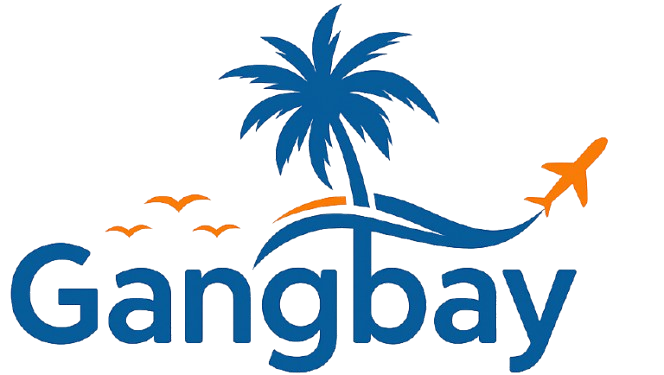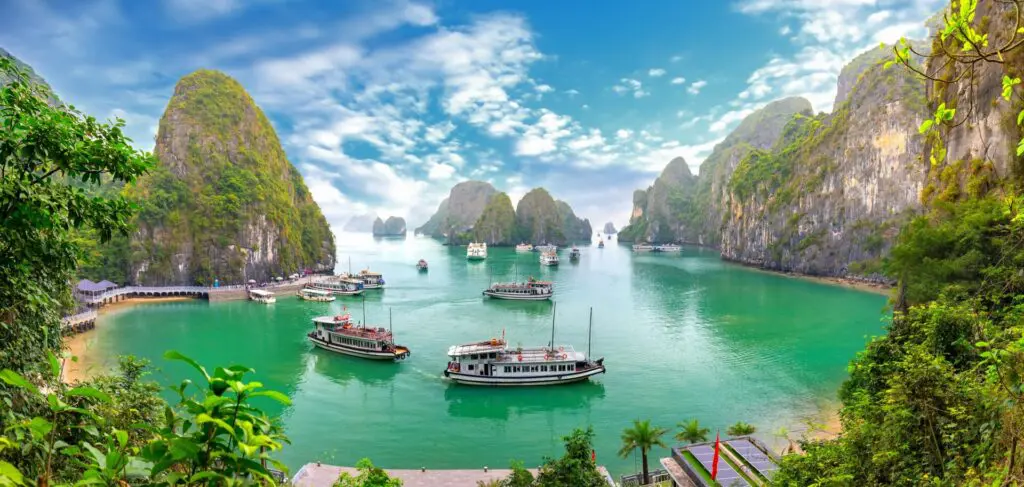Vietnam in 2025 is a land where ancient traditions dance with modern energy, where emerald rice paddies meet bustling city streets, and where every corner tells a story. From the misty mountains of Sapa to the vibrant chaos of Ho Chi Minh City, this Southeast Asian gem offers something for every traveler—whether you’re a foodie, a history buff, an adventure seeker, or someone craving a serene beach escape. I’ve wandered through Vietnam’s lantern-lit streets, savored its steaming bowls of phở, and marveled at its natural wonders, and I’m thrilled to share this comprehensive guide to help you plan an unforgettable trip. Let’s dive into everything you need to know for an epic Vietnam adventure in 2025, packed with insider tips, personal anecdotes, and actionable advice to make your journey seamless and soul-stirring.
Why Visit Vietnam in 2025?
Vietnam is a destination that awakens all your senses. Its rich history, from ancient dynasties to the Vietnam War, blends with a vibrant present, making it a cultural mosaic. In 2025, Vietnam’s tourism industry is thriving, with new infrastructure improvements like expanded airports and expressways making travel easier than ever. The country’s affordability—think a hearty meal for $2 or a cozy guesthouse for $20—combined with its diverse landscapes, from Halong Bay’s limestone karsts to the Mekong Delta’s floating markets, makes it a must-visit. Plus, Vietnam’s commitment to sustainable tourism, with eco-friendly homestays and conservation efforts, appeals to responsible travelers. My first trip to Vietnam left me spellbound by the warmth of its people and the depth of its culture, and I’m betting you’ll feel the same.
Planning Your Trip: Visas, Budget, and Timing
Visa Requirements
Vietnam has streamlined its visa process for 2025, making entry a breeze for many travelers. Citizens from countries like the UK can stay visa-free for up to 45 days, a policy extended in 2023. For others, like US citizens, an e-visa is the easiest option—apply online at least two weeks before your trip for a single-entry visa valid for 30 days. I once helped a friend navigate the e-visa process, and trust me, it’s worth the $25 fee to avoid consulate hassles. Always ensure your passport is valid for six months from your entry date and carry a printed copy of your e-visa for customs.
Budgeting for Vietnam
Vietnam remains one of the most budget-friendly destinations in Southeast Asia. A 2025 survey from Vietnamnomad estimates a three-week trip costs $750–$1,500, depending on your travel style. Here’s a quick breakdown:
- Accommodation: Hostels and guesthouses start at $10–$20/night; mid-range hotels are $30–$60.
- Food: Street food dishes like bún chả cost $1–$3; restaurant meals are $5–$10.
- Transport: Domestic flights start at $30; overnight buses or trains range from $10–$40.
- Activities: Entry to sites like Hue’s Imperial City is $6–$10; a Halong Bay cruise can be $50–$200.
Pro tip: Bargaining is common in markets, but be respectful—smile and aim for 20–30% off the initial price. I learned this the hard way when I overpaid for a conical hat in Hanoi!
Best Time to Visit
Vietnam’s climate varies by region, so timing depends on where you’re headed. The country has three distinct zones:
- North (Hanoi, Sapa): Cool and dry from November to February (15–25°C); rainy from June to August.
- Central (Hue, Hoi An): Dry and sunny from February to May (25–35°C); typhoon season hits September to November.
- South (Ho Chi Minh City, Mekong Delta): Dry from December to April (25–35°C); wet from May to November.
For a balanced trip, March to April or September to November offer pleasant weather across most regions. I visited in April and loved the warm days and blooming landscapes, though I packed a light raincoat for occasional showers.
Getting There and Around
Arriving in Vietnam
Vietnam’s major gateways are Tan Son Nhat International Airport in Ho Chi Minh City, Noi Bai in Hanoi, and Da Nang International Airport. Budget carriers like VietJet and Bamboo Airways offer affordable flights from Asia, while international airlines connect from Europe, North America, and Australia. I flew into Hanoi on a red-eye flight and was greeted by the buzz of motorbikes—book a Grab ride (Vietnam’s Uber) to avoid taxi scams.
Transportation Within Vietnam
Vietnam’s transport network is extensive but can feel chaotic. Here’s how to navigate:
- Flights: Domestic flights are cheap and fast. A Hanoi-to-Da Nang ticket costs around $30–$50 via Baolau.
- Trains: The North-South railway, stretching 1,726 km, is scenic but slow. A soft-seat ticket from Hanoi to Hue costs $25 and takes 13 hours. Book through Vietnam Railways for comfort.
- Buses: Long-distance buses are budget-friendly ($10–$20) and connect major cities. I took a sleeper bus from Hoi An to Nha Trang—comfy but bumpy!
- Motorbikes: Renting a motorbike ($5–$10/day) is thrilling but risky. Always wear a helmet and take photos of the bike to avoid scam claims for “damage.” My heart raced riding through Ninh Binh’s rice fields, but I double-checked the bike’s condition first.
- Local Transport: Grab bikes and taxis are ubiquitous in cities. For short trips, cyclo rides (pedicabs) add a fun, traditional vibe.
Wi-Fi is widely available, so download the Grab app and Google Maps for seamless navigation.
Must-Visit Destinations in Vietnam
Vietnam’s diversity means you can trek mountains, explore ancient cities, or lounge on pristine beaches. Here’s a curated list of top spots for 2025.
Hanoi: The Heart of Vietnam
Hanoi, the capital, blends old-world charm with modern hustle. Wander the Old Quarter’s narrow streets, where vendors sell phở and banh mi. Visit Hoan Kiem Lake for a serene escape, and don’t miss the Temple of Literature, a 11th-century gem. I spent an evening sipping egg coffee at Café Giang—trust me, it’s a creamy delight you’ll crave again.
Halong Bay: Nature’s Masterpiece
A UNESCO World Heritage Site, Halong Bay boasts emerald waters and 1,600 limestone islands. Book a 2-day cruise for $50–$200 to kayak through caves and sleep under the stars. I opted for a less-crowded Lan Ha Bay cruise, which offered the same stunning views with fewer tourists.
Sapa: Mountain Magic
In the northwest, Sapa’s terraced rice fields and ethnic minority villages are breathtaking. Trek to Fansipan, Vietnam’s highest peak, or stay in a homestay with the H’mong people. Pack warm layers for chilly nights. My trek through Mu Cang Chai’s golden terraces felt like stepping into a painting.
Hue: Imperial Grandeur
Hue, the former imperial capital, is a history lover’s dream. Explore the Imperial City, a sprawling citadel with palaces and temples. Take a dragon boat ride on the Perfume River for $5–$10. I was moved by Hue’s blend of grandeur and tranquility, especially at dusk.
Hoi An: Lantern-Lit Charm
Hoi An’s ancient town, another UNESCO site, glows with colorful lanterns. Cycle through rice paddies, get a tailored ao dai (Vietnam’s national dress), or join a lantern-making workshop. I fell in love with Hoi An’s evening markets, where I bargained for handmade souvenirs.
Ho Chi Minh City: Urban Energy
The south’s economic hub, Ho Chi Minh City (Saigon), is a whirlwind of motorbikes and skyscrapers. Visit the War Remnants Museum for a sobering look at history, and crawl through the Cu Chi Tunnels for $20. My favorite moment was sipping coffee at a rooftop café, watching the city pulse below.
Mekong Delta: River Life
The Mekong Delta’s floating markets and lush waterways are a must. Take a boat tour from Can Tho to Cai Rang Market, where vendors sell fruit from sampans. I stayed at a homestay in Vinh Long, learning to cook fish sauce-drenched spring rolls with a local family.
Foodie Heaven: Vietnam’s Culinary Delights
Vietnam’s cuisine is a global treasure, blending fresh herbs, bold flavors, and French influences. Here’s what to try:
- Phở: A fragrant noodle soup with beef or chicken. Try Phở Gia Truyền in Hanoi.
- Bánh Mì: A crusty baguette stuffed with pate, pork, and pickled veggies. Bánh Mì Phượng in Hoi An is legendary.
- Bún Chả: Grilled pork with noodles and fish sauce. Hanoi’s Bún Chả Hàng Mành is a must.
- Cao Lầu: Hoi An’s signature dish with chewy noodles and crispy pork.
- Street Food: From banh xeo (crispy pancakes) to chè (sweet dessert soups), street stalls offer gems for $1–$2.
For vegetarians, check out A Little Adrift’s vegetarian guide for tips on finding meat-free options. Always confirm ingredients, as fish sauce sneaks into many dishes. My first bite of banh xeo in Hoi An, crispy and bursting with herbs, was a flavor explosion I’ll never forget.
Cultural Etiquette and Responsible Travel
Vietnam’s people are warm but conservative, so respect local customs:
- Dress Modestly: Cover shoulders and knees at temples. I carried a scarf for quick cover-ups.
- Be Polite: Greet with a smile and avoid public displays of affection.
- Avoid Scams: Count change carefully and book tours through reputable platforms like Klook. I once caught a vendor slipping me a 20,000 VND note instead of 200,000—stay sharp!
- Responsible Tourism: Support social enterprises, like Hoi An’s Reaching Out Teahouse, which empowers people with disabilities. Avoid exploitative animal tourism, such as elephant rides, and research ethical alternatives.
Comparison Table: North vs. Central vs. South Vietnam
| Region | Top Destinations | Best For | Climate (2025) | Cost (Daily) |
|---|---|---|---|---|
| North | Hanoi, Sapa, Halong Bay | Culture, trekking, history | Cool/dry (Nov–Feb), rainy (Jun–Aug) | $30–$60 |
| Central | Hue, Hoi An, Da Nang | Beaches, heritage, food | Dry (Feb–May), wet (Sep–Nov) | $35–$70 |
| South | Ho Chi Minh City, Mekong Delta | Urban vibes, river adventures | Dry (Dec–Apr), wet (May–Nov) | $40–$80 |
Why This Matters: The table helps you choose regions based on interests and budget. North Vietnam suits adventurers, Central is perfect for culture lovers, and the South offers urban and river experiences.
Suggested Itinerary for 2 Weeks
Here’s a flexible 14-day itinerary covering Vietnam’s highlights:
- Days 1–3: Hanoi – Explore the Old Quarter, Hoan Kiem Lake, and take a day trip to Ninh Binh.
- Days 4–5: Halong Bay – Cruise through limestone islands and kayak in Lan Ha Bay.
- Days 6–7: Sapa – Trek through rice terraces and stay in a homestay.
- Days 8–10: Hue and Hoi An – Visit Hue’s citadel, then cycle Hoi An’s ancient town.
- Days 11–12: Da Nang – Relax on My Khe Beach and visit the Marble Mountains.
- Days 13–14: Ho Chi Minh City and Mekong Delta – Tour the city and take a boat trip to Cai Rang Market.
Adjust based on your pace—I stretched my Hoi An stay to soak in its charm longer.
FAQs About Traveling to Vietnam in 2025
Q: Is Vietnam safe for solo travelers?
A: Yes, Vietnam is generally safe, especially for solo travelers who stay vigilant. Stick to well-lit areas at night, secure valuables, and use trusted transport like Grab. Women travelers should dress modestly in rural areas.
Q: How much cash should I carry?
A: Carry 1–2 million VND ($40–$80) for daily expenses, as many street vendors don’t accept cards. ATMs are widely available, but use those inside banks to avoid skimmers.
Q: What’s the best way to avoid scams?
A: Book tours and transport through reputable platforms like Klook or GetYourGuide. Always confirm prices upfront and count change carefully. Taking photos of rentals (bikes, boats) helps avoid disputes.
Q: Can I drink tap water in Vietnam?
A: No, stick to bottled water or use a filtered bottle like LifeStraw. Most hotels and restaurants provide free bottled water.
Q: Are there vegetarian or vegan options?
A: Yes, especially in cities like Hanoi and Hoi An. Look for “chay” (vegetarian) restaurants, but double-check for fish sauce in dishes.
Q: How do I stay connected?
A: Buy a local SIM card (Viettel or Mobifone) for $5–$10, offering 1–2GB daily data. Wi-Fi is widespread in cafes and hotels.
Conclusion: Your Vietnamese Adventure Awaits
Vietnam in 2025 is a destination that promises to steal your heart. From the chaotic charm of Hanoi’s motorbike-filled streets to the serene beauty of Hoi An’s lantern-lit nights, every moment feels like a story unfolding. My own journey through Vietnam—from getting lost in the Mekong Delta’s waterways to sipping egg coffee in a Hanoi alley—left me with memories I’ll cherish forever. Whether you’re chasing adventure, culture, or culinary delights, Vietnam delivers in spades. Start planning now: book your e-visa, map out your itinerary, and pack light but smart. Check out Vietnam’s official tourism site for inspiration, and consider platforms like The Blonde Abroad for more travel tips. Your Vietnamese odyssey is waiting—go make it unforgettable!








